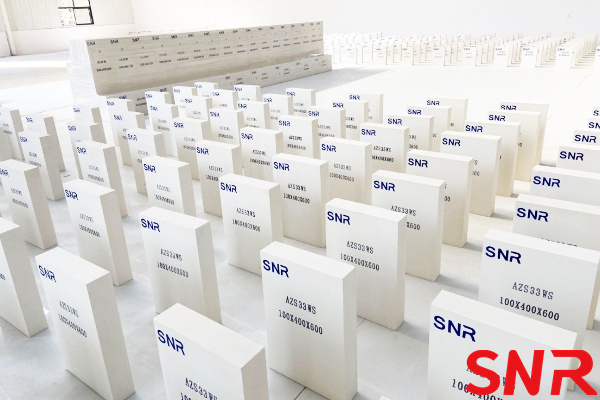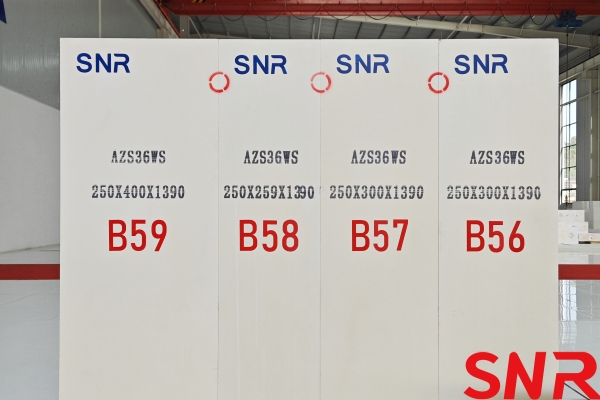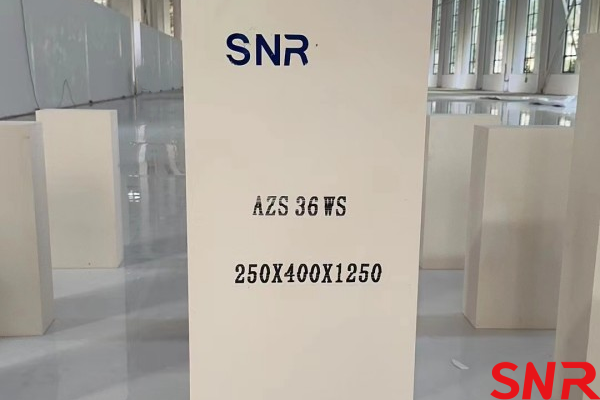Glass furnaces have a defined operational cycle. The design lifespan is one factor, but if production output and quality significantly decline over time while costs rise, the furnace should enter a cold repair phase. In recent years, with advancements in refractory material quality and float glass technology, furnace lifespans have extended from around 5 years to 8 years, with some enterprises achieving up to 10 years. Effectively maintaining and operating the glass furnace to maximize its lifespan and enhance economic efficiency remains a critical focus for glass manufacturers.
1. Selection and Construction of Glass Furnace Refractories
2. Glass Furnace Heating-Up Process
3. Daily Maintenance and Care of Glass Furnaces
4. Hot Repair of Glass Furnaces
5. Proper Utilization of Glass Furnaces
1. Selection and Construction of Glass Furnace Refractories
The choice and installation of refractories are crucial for ensuring long-term, stable furnace operation. During glass production, refractories endure extreme conditions, including temperatures exceeding 1600°C, chemical corrosion, and mechanical wear, directly impacting furnace longevity and efficiency.
Domestic refractory quality has significantly improved, particularly fused cast AZS (zirconia alumina silicate) blocks, which now approach international standards. AZS blocks, known for their excellent corrosion resistance and thermal shock stability, are the preferred material for critical furnace zones. AZS-33 is suitable for general conditions, while AZS-41 (with 41% ZrO₂) is ideal for high-alkali glass environments.


Proper bricklaying is essential. Furnaces operate under slight positive pressure, with fluctuations up to ±50 Pa during firing reversals. Poorly sealed joints allow alkali vapors to penetrate, leading to structural damage (e.g., "rat holes") and accelerated crown erosion. Thus, special refractory mortar must ensure 100% joint filling, with staggered bonding in critical areas. Additionally, expansion joints are necessary for large-span arches to relieve thermal stress.
Recent developments include chromium-alumina (AZCS) bricks, which show superior resistance to high-alkali corrosion due to 5-8% Cr₂O₃ content. Another innovation is graded composite refractories, such as Cr₂O₃-coated AZS bricks, reducing alkali vapor penetration by over 60%.
2. Glass Furnace Heating-Up Process
The heating-up of the glass furnace represents the most critical initial step in its operational lifecycle, significantly influencing both the smooth commencement of production and the long-term performance and service duration of the entire glass furnace.
During this phase, meticulous attention must be paid to temperature control during the expansion stages of various refractory materials, particularly during the rapid expansion phase of silica bricks, where a controlled heating rate of 1°C per hour must be strictly maintained.
Prior to flame reversal, the flue temperature must reach a minimum of 150°C, and the regenerator temperature should not be excessively low. If necessary, induced draft fans should be activated to elevate the regenerator temperature. Failure to maintain adequate temperatures may result in sudden temperature surges in the regenerator following flame reversal, causing severe thermal expansion and subsequent deformation of the regenerator bricks.
Throughout the heating process, both longitudinal and transverse temperature differentials within the furnace must be carefully regulated to prevent uneven brick expansion, which in extreme cases could lead to furnace misalignment or structural cracking.
Upon completion of hot charging, when temperatures approach approximately 1470°C, close monitoring of residual brick shrinkage is essential. Should shrinkage be detected, the expansion joints must be progressively tightened in multiple stages to ensure the crown structure properly accommodates the silica brick contraction while maintaining appropriate stress distribution, thereby guaranteeing crown stability.


Following the heating-up phase, glass furnace insulation should be implemented. Proper insulation can achieve fuel savings of 10% to 15% while significantly improving operational conditions. Additionally, this measure prevents the erosion of expansion joints, which could otherwise lead to crown material dripping and consequent glass quality issues.
3. Daily Maintenance and Care of Glass Furnaces
The routine maintenance of glass melting furnaces is a crucial aspect for ensuring long-term stable operation, requiring the establishment of a systematic and standardized maintenance system.
Particular attention must be paid to the maintenance of the regenerator system, where scientific and effective measures are essential to maintain unimpeded operation - a critical factor for sustaining stable thermal conditions in the furnace.
In daily maintenance operations, periodic blowing of the regenerator checkerwork constitutes fundamental work.
This operation requires detailed procedures: it is recommended to perform top-down sectional cleaning every 3 days using compressed air at 0.6-0.8MPa. Special safety precautions must be observed during blowing operations, with operators required to wear protective face shields and heat-resistant gloves. The cleaning focuses on deposits in different temperature zones: alkali metal condensates in the upper zone (800-1000°C), semi-molten deposits in the middle zone (600-800°C), and solidified agglomerates in the lower zone (400-600°C).
A comprehensive differential pressure monitoring system should be established, with pressure sensors installed at critical locations in the regenerator. Under normal operating conditions, the pressure differential should be maintained below 150Pa, with an enhanced cleaning procedure initiated immediately when exceeding 200Pa.
When severe clogging occurs due to light alkali raw materials, conventional blowing may prove insufficient. In such cases, a specialized high-temperature burning-off process can be employed: by adjusting combustion system parameters to precisely control the temperature at 3 meters above the furnace beam arch within 850-900°C for over 4 hours. The operation requires careful stepwise temperature increases at 50°C/h to avoid thermal stress damage to refractories; during the holding period, combustion air should be reduced by 20% to ensure uniform temperature distribution; upon completion, cooling must be conducted slowly at no more than 30°C/h to prevent material cracking from rapid cooling.
To enhance maintenance effectiveness, a comprehensive treatment combining chemical cleaning with mechanical removal is recommended. Scientific selection of cleaning agents according to deposit composition is essential: acidic cleaners (pH 2-3) for silicate deposits and alkaline cleaners (pH 10-11) for sulfate scale. Professional cleaning equipment such as adjustable-speed rotary wire brushes and high-frequency vibration devices should be provided and regularly inspected to ensure proper working condition.
Enterprises are advised to establish a complete preventive maintenance system including:
►A checkerwork condition archive management system documenting detailed maintenance records;
►Graded maintenance standards implementing appropriate measures according to clogging severity;
►Dedicated maintenance teams with regular professional technical training;
►A maintenance quality assessment mechanism ensuring proper implementation of all measures.
Through scientific maintenance management, energy consumption increases due to regenerator clogging can be controlled within 3%, significantly extending equipment service life. During maintenance operations, special attention must be paid to safety protocols: appointing dedicated safety supervisors, providing necessary emergency equipment, and scheduling work during production intervals to avoid disrupting normal operations. Close coordination with production departments is essential to select optimal maintenance timing for maximum effectiveness.
4. Hot Repair of Glass Furnaces
Hot repair is an indispensable measure to ensure normal furnace operation and extend campaign life. As the primary thermal equipment for glass production, routine maintenance alone cannot resolve all operational issues. Hot repairs enable necessary interventions while maintaining continuous production, allowing the furnace to better serve manufacturing needs.
During operation, certain furnace components frequently experience:
-
Severe localized erosion
-
Excessive thermal degradation
-
Unexpected failuresThese situations demand emergency spot repairs while maintaining molten glass levels and normal furnace operation.
Critical Areas Requiring Hot Repairs:
- Upper tank walls
- Burner ports (combustion openings)
- Forehearth channels
- Crown arches
- Hanger bricks
Multiple hot repairs are typically required for these components during a single campaign to maintain operational stability.
Key Repair Scenarios and Methods:
Even minor cracks require immediate sealing
Delayed response may lead to extensive thinning or complete penetration
Use high-temperature resistant sealing materials
2.Crown Arch Repairs
When erosion leaves only a thin layer above insulation:
Silica refractory maintains structural integrity at 1500°C
Collapse risk remains low due to strong bonding
Critical controls:
Regulate furnace pressure
Implement timely hot patching
Repair methods:
Traditional: Refractory mortar application
Advanced: Spray repair technology
3. Tank Wall Erosion Solutions
Three-layer construction with upper layer most vulnerable
Maximum erosion occurs in batch foam reaction zones (burners 1-3)
Emergency measures (air/water cooling) carry significant risks:
Permanent solutions:
Outer layer reinforcement (maximum once per campaign)
Progressive replacement technique:
Gradually push inner eroded bricks inward
Damage mechanisms:
Thermal stress effects
Common failures:
Steel structure degradation
Brick displacement/sagging
Repair approach:
Internal: Steel plate reinforcement
External: Refractory mortar sealing
Operational Considerations:
Temperature and pressure control is critical during repairs
Advanced repair technologies improve effectiveness
Safety protocols must be strictly followed
Power backup systems are recommended for critical cooling systems
5. Proper Utilization of Glass Furnaces
The correct utilization of glass furnaces is a long-term concern. During daily production, formulating and strictly adhering to reasonable technological parameters is a key aspect in extending the service life of the furnace.
In recent years, the melting area of large glass furnaces has been increasing. For large-tonnage furnaces, the increased span of the crown, along with the gases produced from fuel combustion and raw material heating, can have a certain impact on the deformation of the large crown. During cold repairs of the furnace, severe erosion can be observed on the inner surface of the sunken sections of the large crown.
In severe cases, the crown bricks at 3 to 4 sections of the large crown can be completely eroded and hollowed out, covering an area of 3 to 4 m². Particularly around the thermocouple holes in the high-temperature zone, if not handled properly, the surrounding area is especially prone to erosion, to the extent that thermocouples may not even be insertable in the later stages of the furnace‘s operation. This is primarily due to the erosion of silica bricks by a large amount of mirabilite vapor generated from the increased volatilization of alkalis and mirabilite in the fuel and raw materials at high temperatures.
The following reactions occur between the SO₃, CO₂, and H₂O produced from fuel combustion and the Na₂CO₃, Na₂SO₄ in the batch materials, as well as the Na₂O generated in the molten glass:
Na₂O + SO₃ → Na₂SO₄
Na₂CO₃ + SO₃ → Na₂SO₄ + CO₂
Na₂O + H₂O → 2NaOH
2NaOH + SO₃ → Na₂SO₄ + H₂O
Na₂SO₄ + 2SiO₂ → Na₂O·SiO₂ + SO₃
Above 1000°C, the reaction between Na₂SO₄ and SiO₂ becomes more intense, particularly noticeable in the gaps of the brickwork. Since the melting point of Na₂SO₄ is 884°C, mirabilite vapor forms a liquid phase that adheres to the brick surface, causing erosion of the silica bricks. Therefore, the use of light soda ash should be minimized, and the moisture and alkali content of the batch materials should be controlled to reduce flying dust. The temperature of the furnace crown should be maintained within a reasonable range, with the large crown temperature not exceeding 1600°C. Although the application of L-shaped hanging walls has increased the temperature of the No. 1 crown section, temperature control should still be based on the principle of being able to melt the batch materials.
Additionally, controlling the fluctuation of the molten glass level can reduce erosion of the tank wall. The most effective method is to insert an intermediate water-cooled jacket at the charging port to guide the batch materials towards the center and away from the tank wall, thereby eliminating the scouring effect of the "V-shaped" or biased batch materials on the tank wall.
Once a glass melting furnace has been constructed and fired, its operation and maintenance become inseparable aspects upon its commissioning.
To extend the service life of the glass melting furnace, it is essential to foster an awareness of the mutual advancement and coordination between production and furnace maintenance.Regular inspections should be conducted to monitor the implementation of various technological parameters and the extent of burn damage to the furnace.Timely hot repair plans should be formulated, along with maintenance and preservation measures.
At the same time, strict control should be exercised over the "four small stabilities" in furnace operation to achieve stable melting and overall furnace stability.


Henan SNR Refractory Co., Ltd. has been specializing in the production of fused cast AZS blocks for about 25 years. We use high-quality raw materials and advanced fusion technology to provide customers with high-quality products. From raw material procurement to finished product delivery, every step is strictly quality inspected to ensure that every indicator meets the standards, so you can use it with confidence.
 If you have any needs, you can contact me at any time.
If you have any needs, you can contact me at any time.
Web:www.snr-azs.com
Email:wendy@snrefractory.com


